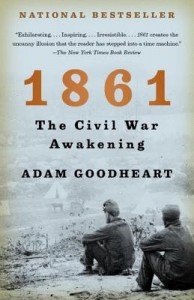UNDER THE FREEDOM TREE by Susan VanHecke, illustrated by London Ladd (Charlesbridge, 2014)
Under the Freedom Tree tells the story of three runaway Confederate slaves who steal away under night’s blanket of protection and row their weathered skiff to the Union side. They’re seeking freedom, a chance to build a life for themselves, but if they’re caught, “Shackles. The whip. Sold downriver. Or worse.”
VanHecke’s free verse is stunning, rich in imagery. Readers will hang on every word as James Townsend, Frank Baker, and Shepard Mallory stand bravely before Union General Benjamin Butler and await their fate. When the Confederate messenger arrives, wanting their slaves returned, Butler boldly seizes them as contrabands of war – enemy property – because Virginia has seceded from the union of states. This opens the door for, “hundreds, then more. Runaways. Stowaways. Barefoot, mud-crusted” to flee. The road to freedom is lengthy, but because of the courageous decisions of Frank, James, and Shepard – they help deliver their race from the shackles of slavery. Ladd’s illustrations are nothing short of magnificent. Bold, emoting, and intense. His light illuminates on every page, drawing the human eye to the drama. An author’s note and bibliography round out this exquisite piece of children’s literature. For ages 6 to 9.
We asked Susan VanHecke and London Ladd if they’d share a few behind-the-scene moments about how this story was born, and part I of our interview begins with Susan in 3, 2, 1…

What inspired you to write Under The Freedom Tree? And why do you think this story is important for young readers?
Several years ago, I ran across a striking photo of a huge old oak tree in the back of a local magazine here in southeastern Virginia, where I live. The caption described the tree as where area slaves heard the Emancipation Proclamation in what some scholars believe was the first reading of that document in the South. Turns out, without ever realizing it, my kids and I’d driven by this tree—which stands on the campus of Hampton University, just a few miles from our home—countless times. How could we have not known about such an important landmark? Why hadn’t my children learned about this historic place at school?
As I started to research, I was excited to learn the full story. I cheered the runaways Frank, James, and Shepard for bravely taking their fate into their own hands and rowing to the Union line. I applauded Union General Butler’s decision to not return the fugitives to the Confederates, claiming them instead as enemy “contraband.” I marveled at how the thousands of contrabands who then streamed into Fortress Monroe built their own communities out of the Confederates’ rubble and went to work for the Union. I was thrilled by the contrabands’ illegal reading and writing lessons taught under that big tree’s branches. And I rejoiced at the contraband slaves learning of their freedom under those same branches when the Emancipation Proclamation was read a couple of years later.
This was a fresh new view of the road to emancipation, and I wanted my children and their classmates to learn this remarkable history. It’s important to know that African Americans were courageous and active participants in securing their own freedom. The “classic” version of emancipation shows freedom bestowed upon the helpless slaves, and that’s actually far from the truth, many historians point out.
The story is written in free verse, why did you choose this style and structure?
I tried for a couple of years to write the contrabands’ story in prose. But it was too dry, too flat; it just didn’t seem to capture the drama, the emotion, at the core of the tale.
Frank, James, and Shepard were surely terrified when they stole that skiff and rowed nearly three miles by moonlight to the Union line, not knowing what would happen when they got there. Those thousands of runaways who, hearing of the new “contraband” status, made their muddy, dusty, dangerous way to Fortress Monroe were certainly determined, driven, and full of hope. The contraband children taught their 1-2-3s and A-B-Cs under that sheltering oak tree must have been excited to learn these basic skills so long denied to their people. And, wow, can you imagine the jubilation when President Lincoln’s important document was read under that tree, which would come to be called Emancipation Oak?
It seemed that poetry might be the best way to capture all of that. When I visited Emancipation Oak myself—it’s open to the public—I envisioned all that had happened near and under the tree during the Civil War. I could feel all that emotion, and the words just started flowing.
What are the challenges in writing a big story “slaves escaping to freedom” like this? And how do you balance the emotions and facts in a way that doesn’t leave one side top-heavy?
Great question. I think my background in newspaper and magazine journalism helped keep me on track with the just-the-facts “reporting.” Reading slave narratives from the area gave a voice, at least in my head, to the characters in the book. And the many amazing vintage photographs and illustrations of the contrabands and their struggle that I discovered in my research added that human element. You can check out a gallery of those images at the book’s website, www.underthefreedomtree.com.
We were also privileged to have Civil War scholar Dr. Adam Goodheart, author of the bestseller for adults 1861: The Civil War Awakening, vet Under the Freedom Tree for accuracy. His insight and expertise were invaluable.

What part of the story did you connect with the most? Why?
For the sheer drama of what they pulled off, the three slaves’ nighttime escape from the Confederate line still gives me goosebumps. When illustrator London Ladd visited my area to research, we stood at the very point where the runaways began their journey. It was quite moving—and intimidating—to see the wind tossing the waves, the other shore barely visible off in the distance. What Frank, James, and Shepard did was pretty heroic.
As a mom and a writer, those lessons under the tree really resonate with me. Mary Smith Peake, the free black teacher who willingly broke the law to teach the contrabands to count and write and read, is without a doubt another hero of this tale.
Part II of our interview with illustrator London Ladd will follow shortly so stay tuned! Also a downloadable educator/curriculum guide created by ReaderKidZ’s Debbie Gonzales can be found by clicking HERE.











Thanks for this review. Looks like a fantastic book; I just added it to my TBR list!
Thanks, Carol! You’re going to love this one! Author and illustrator really dialed it up when they collaborated on this project.